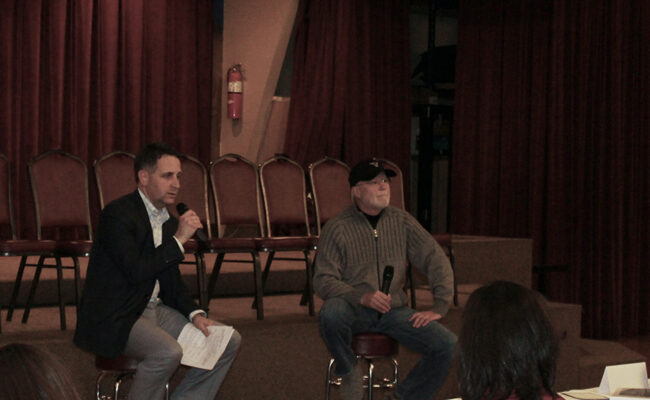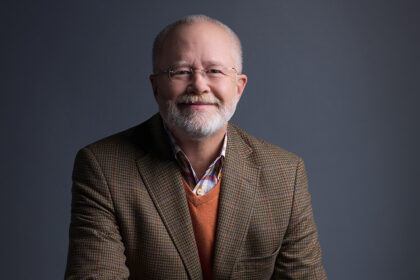Latest News
Jeff Scherschligt Reflects on the Intersection of Leadership and Philanthropy

Last week, President Andy Patterson spoke to graduates of Leadership Sioux Falls 35 about the impact of philanthropy in our community. Following his remarks, Patterson interviewed former SFACF Board Chair, philanthropist and local business leader Jeff Scherschligt about the inspiration behind his giving, his mission to make a difference and how today’s rising leaders must continue to create a culture of giving and care. Leadership Sioux Falls participants had a chance to ask questions as well.

Q. You grew up in Sioux Falls and built your career here. How has that influenced your approach to philanthropy and what can rising leaders learn from your experiences?
A. I feel so fortunate to have grown up in this community. I’ve had success here and I’ve always believed in the importance of giving back — and giving back in multiple ways.
I’ve been lucky to have had great mentors along the way who helped teach and shape me. As business leaders, I think it’s so important to pay that forward. As an example, I was in the first Leadership Sioux Falls class. Now I’m here talking to Leadership Sioux Falls 35.
You know, one thing that’s made Sioux Falls so special over the decades has been the idea that when it comes to philanthropy and things that are good for this community, our business leaders have always come together to do what’s best for our community – not necessarily what’s best for ourselves or our businesses. That’s a very unique philosophy; a unique culture. When I see future leaders, I try to say, ‘folks, keep fighting to maintain that culture.’ That spirit of giving and care is cornerstone to this community.
Q. From your perspective, how can local businesses inspire philanthropy among employees?
A. If you have leaders at your work who engage in giving and believe in the concept, it can float down to all the employees. As they learn about the impact of giving, they’ll be inspired to take part. It’s leadership. It’s mentorship. It’s being involved. We need to ensure the next generation of leaders continues to live this out.
Q. Any advice for today’s emerging leaders as they begin the philanthropic journey?
A. Everyone has a level or percentage that they feel comfortable giving at — and that’s fine. What’s important is that we give — that philosophically, we commit to a percentage.
I’ve always called it the ‘nonprofit tax.’ We don’t have an income tax in South Dakota, so in lieu of that, what if we all gave 5 percent to nonprofits?
Like any giving, I think those with means can and should give more. I’ve tried to be a leader in giving. And when I’m involved in fundraising efforts, I make sure to try to give at the level I’m asking for. I think that’s important. I tell people, ‘give to the point where it stretches you, especially if you’re in a leadership position.’ Leaders need to step up and show they’re trying their best.
Q. At its core, philanthropy is about people helping people. Beyond giving of your resources, you’ve made a point to give of your time and talents as well. As you look back throughout your career, how did you choose what efforts or organizations to support?
A. We talk a lot about ‘time and hustle’ in business. When it comes to giving, we talk about passion. You need to make sure that as you commit volunteering for fund drives or boards that you’re passionate about the cause or the organization you’re serving — otherwise it can just feel like work. And if it’s not enjoyable to you, it will show.
Q. What guiding principles do you employ when you consider your giving?
A. Well, we all have our own passions. But I always try to first take a look at what our community has established — things like the United Way and the Chamber appeal — both process-driven and efficient efforts. After that, I look to my own interests and passions and try to align my giving with the pillars of our community, things like supporting parks, educational programs and helping our youth, support for the environment, the arts and so on.
Whatever I’m giving to, I always tried to be a ‘happy giver.’ If you can learn to make your giving feel good, it really will make a difference.
How do you make it learn to feel good? By always remembering that your gift is making a difference.
You know, we’re not going to be able to take a thing with us once our time is up. But you know what? We can take the feeling of knowing that we made a difference in someone’s life.
Q. Giving for today or giving for the long term? Discuss your strategy.
A. The Community Foundation is a foundation for good, for ever. As I’ve become more involved with the Foundation over the years, I’ve come to look at it as basically 10 percent of my giving goes toward the longer term approach — putting money in endowments that will help take care of our community long into the future.
So, 90 percent for the needs of today and 10 percent into approaches that will have long-term impact.
Q. Can you share some of your most favorite philanthropic endeavors?
A. A few come to mind. As we were planning for Cherapa, we needed to take down the Zip Feed Mill. Around that same time, my daughter was diagnosed with MS at age 19. We made the “Big Boom” into a fundraiser for the MS Society and ended up raising about $150,000 for that. That was pretty special.
Good Earth State Park is another one. You know, I believe in setting aside land and I believe in parks. Good Earth was the first new state park created since 1970. In addition to being a very culturally significant site, it’s also right on the doorstep to our city, which means it can also drive tourism. So many families enjoy it, and will for generations to come. That’s something that really stands out to me.
Good Earth was also an example of partnering with the state. I’m a big believer in public-private partnerships. That’s how stuff really gets done today. If you unite a public effort with the passion and support from private philanthropists, it seems like things really get done, they move efficiently and the results are embraced by the community.
Q. What are you working on now, and what’s next for you?
A. Well, I’m officially retired now but I do have a new title that I really love, and that’s ‘grandpa.’ But at the same time, I am finding that I still have energy and I still have a desire to make a difference in this community. From a project standpoint, right now I’m working on a vision for Cherapa 2 in collaboration with the City of Sioux Falls.
From a nonprofit standpoint, I continue to be involved in projects related to area parks.
My wife and I love Sioux Falls and we’re committed to this place. So I will continue to keep my eye on what’s important to this community and what makes a difference in the lives of those who live here.
You know, we’re only here for a short little ride. So I hope I can make a difference. I hope that one day my grandkids can say, ‘hey, grandpa had a little something to do with that and it made a difference in this community.’
It excites me to see emerging leaders who are also passionate about making a difference — because that’s the key to building a brighter future for this place we all love.
